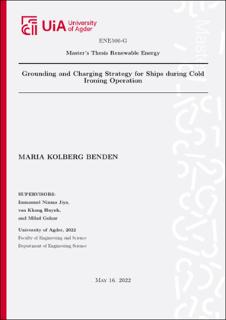| dc.description.abstract | In order to minimize the pollution that ships generate at ports, ships can be connected to the utility grid during charging, also known as shore-to-ship connection or cold ironing operation. The pollution can also be remarkably reduced if the ships are full-electric or hybrid. With the utilization of a common DC bus, several ships can be charged simultaneously. However, due to the common DC bus, the ships are not galvanic isolated from each other such that leakage current can occur among the ships and the quay when the current leaks to the ground during a fault. Hence, this paper proposes a complete charging and grounding strategy, which will provide galvanic isolation between the ships and the quay. The charging and grounding strategy are verified through simulations in the Matlab/Simulink environment. An isolated and ideal PSFB DC-DC converter with a rated power of 400 kW was proposed to obtain galvanic isolation. The proposed converter obtained a stable output during nominal and half load from the simulation results. In addition, two grounding systems on the shore-side and the ship-side were proposed. On the shore-side, a double grounding TN-C grounding system with a NGR resistor was designed such that the leakage current can easily be detected when a ground fault occurs. On the ship-side, an IT system with HRMG resistors was designed to reduce the leakage current such that the risk of corrosion was reduced and provided safety for personnel. As a result, a fault on the shore-side did not affect the ship-side grounding system and opposite. Faults that can appear on the charging system were found through research and simulated with the complete charging and grounding system to verify that the grounding system was optimally designed. The results during a fault on the system showed that the shore-side grounding system was not optimally designed because the NGR did not reduce the fault current to a lower value than 25 A. The common DC bus was created from an uncontrolled rectifier that suffered a substantial power dissipation. As a result, the output of the PSFB DC-DC converter was unstable. Therefore, a resistor was added to the TN-C grounding configuration during simulations of the charging system to achieve a stable output of the DC-DC converter. The IT grounding configuration on the ship-side reduced the fault current to 6 mA during a LG fault, and personnel safety was kept at a safe level when a person touched one of the DC lines. However, it was shown that the personnel safety was not obtained when a person touched the energized chassis due to a dangerous voltage potential. | |
